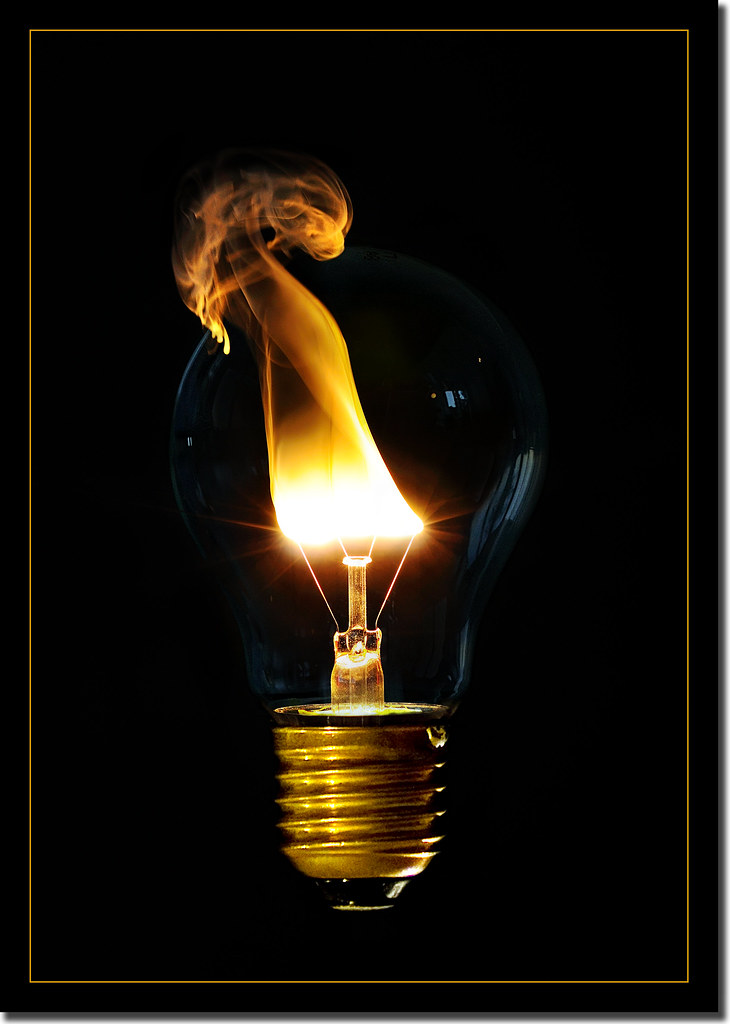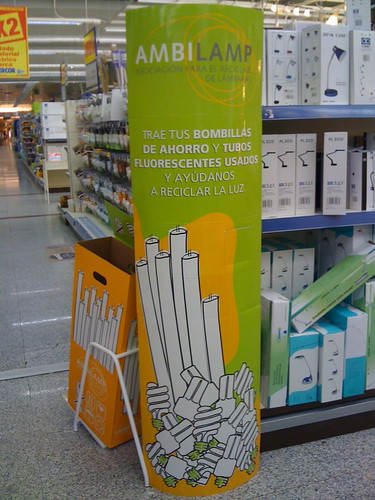
Photo credit _Beat_???
Well, the EU thinks it takes 27 countries to change the light bulb. And they may well be right.
Today the EU brings into force a ban on frosted and incandescant lightbulbs of 100W and over. This is the first part of a program to completely phase out incandescent light bulbs in the EU by 2012. According to the EU announcement, as a result of this
EU citizens will save close to 40 TWh (roughly the electrictity consumption of Romania, or of 11 million European households, or the equivalent of the yearly output of 10 power stations of 500 megawatts) and will lead to a reduction of about 15 million tons of CO2 emission per year.
However, this message doesn’t appear to be getting through to many of the EU citizens with many reports of people hoarding 100W lightbulbs across Europe.
Reasons for the hoarding are understandable. The light quality from CFL’s is not comparable to incandescents. CFLs lights are not dimmable. They are more expensive (at least as an initial outlay) and they need to be disposed of carefully as they contain small amounts of mercury. Fortunately our local Hipercor store has a special collection point for safe disposition and recycling of CFL’s. If your shop doesn’t, ask them why not!
However, on the positive side, what this ban does is it creates a large market of consumers (EU population is approx 500m people) hungry for good lighting solutions. This should act as a serious spur for innovation in the lighting space. The current alternatives to incandescent lights are CFL’s, Halogen lights and LEDs.
Of these, the CFLs have the limitations outlined above. Halogen bulbs have light quality equivalent to incandescents but they are not very energy efficient, saving at best 25-50% over incandescents (as compared to CFLs saving typically 75%) while still being expensive and LEDs are still quite an immature technology.
The LED light though holds the most promise. LEDs are mercury free, they are fully dimmable, their lifetime can be 50,000 to 60,000 hours (or about 10 times longer than an average CFL), there is no bulb or filament to break and they are extremely energy efficient. There are some barriers to their widespread adoption currently (they are expensive to produce and LEDs are quite directional) but the sudden appearance of a marketplace of 500m people will definitely act as an incentive to invest in overcoming these difficulties.
Thanks in no small part to today’s ban, in a few short years I expect we will all be using LEDs to light our homes and reducing our carbon footprint considerably in the process.
Related articles by Zemanta
- Big turn off (news.bbc.co.uk)
- Europe’s Ban on Old-Style Light Bulbs Begins (nytimes.com)
- Defra lacks power to ban our bulbs (telegraph.co.uk)
- EU bans old-fashioned light bulbs (news.bbc.co.uk)
- Frosted light bulbs to be banned by EU (telegraph.co.uk)
- Industry Looks to LED Bulbs for the Home (nytimes.com)



I was surprised to hear that not only the 100w is on it’s way out, but also the 75w in 2010, the 60w in 2011 and even the 40w isn’t safe with it going in 2012. I think people that are worried about the extra costs involved with the energy saving bulbs should realise that they last longer, thus need less replacing.
The move to eliminate incandescent bulbs is accelerating rapidly. And, while LED technology represents an option, there are still issues with light quality and color. Two companies — QD Vision and Nexxus Lighting — in May announced an LED lamp that addresses these issues. The new lamp uses quantum dot technology to combine the familiar warmth and color of LED lighting with the efficiencies of LED technology. You can read more about the new LED lamp here — http://www.technologyreview.com/energy/22641/. QD Vision’s Quantum dot technology is also being aimed at the display industry where it will improve clor and light quality while reducing energy use.
Nice light bulb illustration.. even if a bit sad!
Unlike many people against the ban,
I agree with the need to do something about emissions
(for all they contain, whatever about CO2)
But banning light bulbs is not the way forward,
and I think people who are less in agreement with
the background arguments will just be turned off from cooperating in more important environmental measures.
Let’s think about this:
Europeans (like Americans) choose to buy ordinary light bulbs around 9 times out of 10 (EU Commission and light industry data 2007-8)
Banning what people want gives the supposed savings – no point in banning an impopular product!
If new LED lights – or improved CFLs etc – are good,
people will buy them – no need to ban ordinary light bulbs (little point).
If they are not good, people will not buy them – no need to ban ordinary light bulbs (no point).
The arrival of the transistor didn’t mean that more energy using radio valves were banned… they were bought less anyway.
The need to save energy?
Advice is good and welcome, but bans are another matter…
people -not politicians – pay for energy and how they wish to use it.
There is no energy shortage – on the contrary, more and more renewable sources are being developed –
and if there was an energy shortage, the price rise would lead to more demand for efficient products anyway – no need to legislate for it.
Supposed savings don’t hold up anyway for many reasons:
http://www.ceolas.net/#li13x onwards
about brightness, lifespan, power factor, lifecycle, heat effect of ordinary bulbs, and other referenced research)
Effect on Electricity Bills
If energy use does indeed fall with light bulb and other proposed efficiency bans,
electricity companies make less money,
and they’ll simply push up the electricity bills to compensate
(especially since power companies often have their own grids with little supply competition)
Energy regulators can hardly deny any such cost covering exercise…
Emissions?
Does a light bulb give out any gases?
Power stations might not either:
Why should emission-free households be denied the use of lighting they obviously want to use?
Low emission households already dominate some regions, and will increase everywhere, since emissions will be reduced anyway through the planned use of coal/gas processing technology and/or energy substitution.
Direct ways to deal with emissions (for all else they contain too, whatever about CO2):
http://www.ceolas.net/#cc10x
The Taxation alternative
A ban on light bulbs is extraordinary, in being on a product safe to use.
We are not talking about banning lead paint here.
This is simply a ban to reduce electricity consumption.
Even for those who remain pro-ban, taxation to reduce consumption (and therefore energy use and emissions) would make more sense, also since governments can use the income to reduce emissions (home insulation schemes, renewable projects etc) more than any remaining product use causes such problems.
A few pounds/euros/dollars tax that reduces the current sales (EU like the USA 2 billion sales per annum, UK 250-300 million pa)
raises future billions, and would retain consumer choice.
It could also be revenue neutral, lowering any sales tax on efficient products.
When sufficent low emission electricity delivery is in place, the ban can be lifted
http://www.ceolas.net/LightBulbTax.html
Taxation is itself unjustified, it is simply a better alternative for all concerned than bans.
Of course an EU ban is underway, but in phases, supposedly with reviews in a couple of years time…
maybe the debate in USA and Canada will be affected by the issues raised?
peter in dublin,
You lost me at “no point in banning an impopular product!”. Good luck with that argument.
Sam
Ok so I couldn’t resist to have a look further into your argument, but only got as far as the comparison between transistors (better/faster/cheaper) and valves (inefficient/slow/expensive). Incandescents are cheap to produce but expensive to run. Do you really think people will make the right choice at the supermarket aisle? No. CFLs have been around a *long* time and they’ve barely made a dent in the incandescent market.
Sam